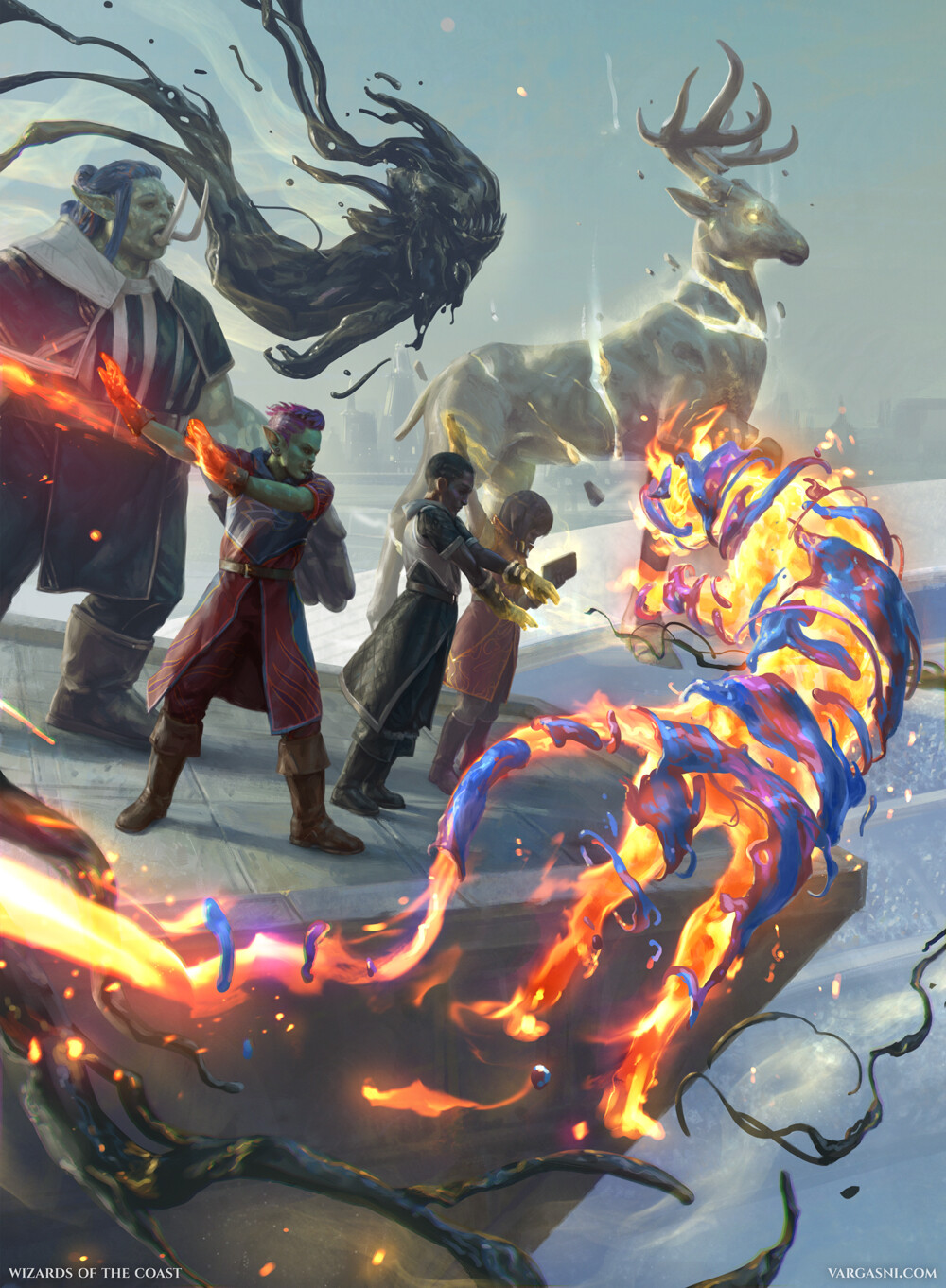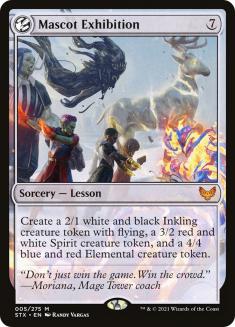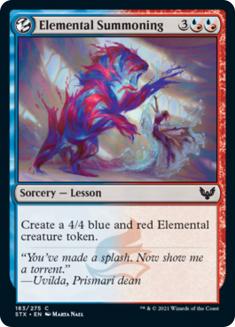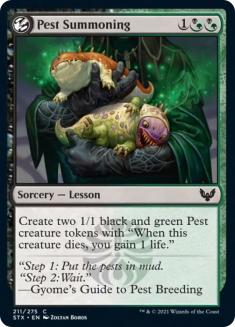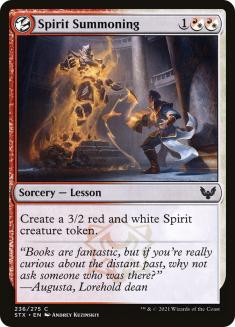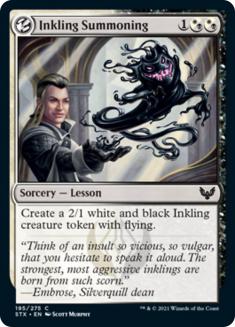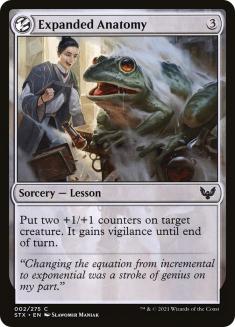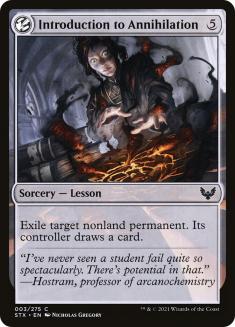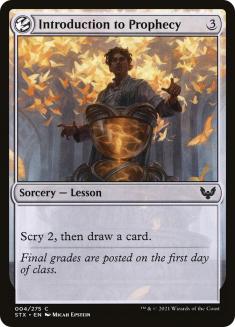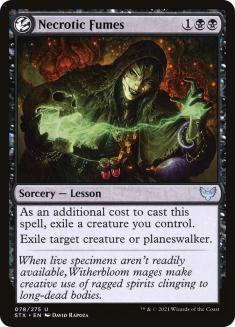Drafting Lessons is a completely different strategic element from anything we’ve ever had in Limited, and so far, people aren’t doing a great job of passing the test of understanding them properly. How do I know? The 17Lands.com data, of course!
Early in a format, I like to use 17Lands.com’s stats to double check my expectations about which cards are the best. Recently, I’ve gotten into a lot of debates on Twitter about how best to use the stats, which is a tough question, since there are a lot of different things you could prioritize. Personally, I use game in hand win rate (GIH WR) as the strongest overall indicator of a card’s power level.
I came to the conclusion that this was the best stat to use by sorting the list of cards by each possible metric, and evaluating how closely the results lined up with my beliefs about which cards are the best. (I’ve talked to other players who know that they prefer aggressive strategies, so they prioritize ranking cards by opening hand win rate. If you have a strong enough preference for aggressive decks, I think that makes sense, but I do think it leads to a list that does a worse job of capturing a card’s “natural” win rate/strength.) So far, across every format, GIH WR is the one stat that’s produced lists that line up with my beliefs.
Does that scientifically prove anything? Absolutely not. Has it been useful for me? Yes, very.
Because there’s roughly 90% agreement between the ranking generated by sorting the cards by that metric and my intuitive ranking, it tells me that anywhere there’s disagreement is a point that I should re-evaluate. Most likely, one of two things is happening. Either I’m wrong about the card, which makes sense, because 17Lands has a lot more “experience” with the card than I do, or there’s some fluke with a particular card that offers a plausible explanation for why its numbers would be exceptional, like a way in which the card works differently from other cards.
One place where that applies is Lessons. GIH WR doesn’t tell you anything about how highly you should prioritize Lessons. The nature of Lessons is that they only enter your hand when you want them, so a Lesson version of Hidetsugu’s Second Rite would likely have a very high GIH WR, while contributing very little to the success of a deck. The best metric for Lessons would likely be “win rate when drafted,” which would only really be useful for comparing Lessons against each other anyway, and isn’t currently published. So my analysis of drafting Lessons is based on my experience and theory, not statistics.
If that’s true, how can I claim the statistics tell me people are doing it wrong? By looking at the cards that learn.
I mentioned that I like to use 17Lands.com to check my beliefs about a format. So I looked at the cards sorted by how early they’re taken, which is a clear indicator of how highly players prioritized them, and then looked at the corresponding win rates to see which cards are overvalued and undervalued. Theoretically, a card that’s taken later is paired with better support, which could account for it winning more often, but this esoteric point mostly gets brought up by people who are looking for reasons not to trust the data. Almost all cards that are taken late don’t win very much — the card is bad, so it doesn’t win much, and people don’t draft it highly.
There are a few cards that win a lot but aren’t taken highly. It seems clear to me that cards that have a much higher win rate than other cards that are taken similarly are being substantially underrated. For the most part, I think a card’s strength is a much stronger indicator of its win rate than when it’s taken is, so I feel pretty confident almost entirely ignoring when a card is taken in estimating a card’s power level. However, some people disagree with me on this.
Regardless, using this method, the cards that stood out as the cards that were most undervalued in the set were consistently every card that learns (except First Day of Class), particularly those with other text that doesn’t look very strong. Guiding Voice and Study Break have the second- and third-highest win rates among white commons behind Combat Professor. Arcane Subtraction and Pop Quiz are fourth and fifth in blue behind Bury in Books, Frost Trickster, and Curate. Hunt for Specimens has the highest win rate among black commons, but it’s drafted three picks later on average than Mage Hunters’ Onslaught (I’m not suggesting that that accounts for the difference; players are misevaluating these cards — Hunt for Specimens is better). I don’t know why black only gets one common that learns.
Enthusiastic Study is the red common with the third-highest win rate, behind Heated Debate and Pigment Storm. Field Trip is the green common with the fourth-highest win rate, after Professor of Zoomancy, Mage Duel, and Scurrid Colony (which is actually even more underrated). Black and green each have one common learn card while the other colors have two, and there are two hybrid learn cards in Cram Session and Rise of Extus. Cram Session is the second-weakest learn card (playable, but unexciting) and Rise of Extus is the common with the sixth-highest win rate when drawn behind Professor of Zoomancy, Heated Debate, Bury in Books, Combat Professor, and Mage Duel (ignoring the Lessons).
The uncommons and rares that learn are fantastic. This tells us that learning is powerful, so it stands to reason that we should understand and prioritize Lessons. For further evidence of that, consider this tweet:
So Lessons are great, but not all Lessons are created equal, and as I said, I don’t think the stats we have available can help sort out which ones we need to prioritize, so it’s time for some good old-fashioned theory.
If you have a good number of learn cards, your Lessons are kind of like companions — they’re cards you can always expect to have access to. This makes Mascot Exhibition the best card in the set, because it’s an extremely high-impact play that you can plan for and count on making every single game. There’s no card I would take over Mascot Exhibition Pack 1, Pick 1, and it’s extremely rare that I’d pass it at any stage of a draft. The opportunity cost of any single card just doesn’t compare with the strength offered by having this card in your sideboard.
You won’t see Mascot Exhibition often, so that’s not very important, but it’s worth noting. Now let’s get to the common Lessons that really make up the backbone of this format and give it its identity.
There isn’t a single “best” common Lesson. They serve different roles and various decks prioritize them differently. In general, you want access to a range of Lessons to fill different needs, but the most important thing is getting the go-to Lessons for your archetype.
For me, the most pivotal Lesson is Environmental Sciences. If you have a single Environmental Sciences, every card that learns becomes a potential mana fixer. That means that there are five rares, six uncommons, and ten commons that become fixing for you. That’s a staggering number compared to the amount of fixing available in most sets. That one pick sets you up to consistently have perfect mana if you prioritize learn cards, which you should want to be doing anyway for their other utility. To me, “Should I splash in Strixhaven?” comes down almost entirely to, “Do you have Environmental Sciences?” if yes, go for it; if not, it’s going to be tricky.
I think some people think about Environmental Sciences like Prophetic Prism, a card that makes splashing much easier by essentially adding N colored sources to your deck, where N is the number of colors you’re playing. In reality, that single pick added N times the number of learn cards you drafted to your deck. I’ve drafted several successful three-color decks with dreadful “6/6/6” manabases (decks with one dual land and sixteen basics that result in six lands that can tap for each color of mana), but because I have two learn cards in each color that I can use to find either of the other two colors that I’m missing, it plays more like 10/10/10 mana (with a note that I’ve gotten myself into trouble with things that cost two colored mana in these decks — you need to be careful about that).
So when should you draft it? If I think I might want to splash, I try to take my first Environmental Sciences over anything that isn’t a bomb just so that I know I have it. What counts as a bomb and how do I know if I might want to splash? Well, at the beginning of a draft, I assume I might want to splash until I have a reason to believe I don’t, and as a rough guess, I’d say at the beginning of a draft I’d treat Environmental Sciences as a card with roughly a 58% win rate. This number isn’t based on anything scientific, just looking at the cards sorted by win rate and trying to find the line for where I’d take cards over it in practice. I expect this number to change a little over time.
Early on, I don’t want to give up a very strong card even though I think the first copy of Environmental Sciences will have a larger impact on my deck, just because I might see one later that I could take over a weaker card, and while the first copy is worth a lot, the second copy is worth very little, so if I take it early, I’m lowering the average value of my future picks by essentially eliminating any future value I’d gain from seeing another copy later. In other words, if it were rare, I’d take it much more highly, but because I only want one, I draft it a little lower.
On the other hand, there’s value to taking it early and knowing you have it, because it lets you draft cards you want to splash while knowing you’ll be able to play them, rather than needing to factor in the probability that you’ll find an Environmental Sciences later in the draft to let your mana work.
The more aggressive my deck and the steeper my mana requirements in two colors are, the lower I’m going to prioritize Environmental Sciences, because those factors make it less likely that I’ll want to splash. Also, having other good Lessons I want to find or having few learn cards would make me prioritize it less, as those will decrease how often I’ll have access to it or how valuable that option is.
If I know that I’m splashing, the splash is strong, I have a good number of Lessons, I don’t have an Environmental Sciences, and I’m running out of time to find one, I could happily take it over literally any card in the set (even Mascot Exhibition in the most extreme cases, but that’s unlikely).
As I see it, half the archetypes in the format require a single copy of Environmental Sciences. Taking it early unlocks a huge number of options for you, so you should be very careful about ever passing this card if you don’t already have one.
The next-most-impactful common Lesson is Fractal Summoning. As an X-spell, it’s not surprising that it’s high-impact. If you have a Fractal Summoning or two, your deck can get away with playing very few threats and win by pulling Fractal Summoning to make a huge Fractal after you’ve taken control of the game. If you reach a late-game state where both players have a lot of lands and not much going on, you’re much more likely to win a topdeck war if any Lesson gives you a threat that’s likely bigger than every creature in your opponent’s deck. In particular, this is great for making sure that Quandrix ramp and Prismari control decks consistently have something to do with a lot of mana in the late-game.
Elemental Summoning is a step down from Fractal Summoning, but a suitable replacement. I don’t mean that it’s strictly worse — it’s lower-impact, but better at turning a corner. If you have really strong late-game stuff, you’d prefer Elemental Summoning; if your deck’s strength is ramp and interaction and you want a finisher, you’d prefer Fractal Summoning. This is a great card to lock up the ground and begin turning things around in a control deck, and a perfect follow-up to Field Research in a Quandrix deck, or high-impact Lesson for a Lorehold deck.
Pest Summoning is the glue that makes Witherbloom decks work. There are a lot of cards that care about gaining life or sacrificing creatures, and a common way to get things started in Witherbloom is to Hunt for Specimens and grab Pest Summoning. It’s a lower priority for Quandrix and Silverquill decks, but it can still be useful to have access to.
Spirit Summoning and Inkling Summoning are functional aggressive threats that play well if you cast an early learn card and you’re just looking for a body to curve out with, but I think these are not especially high priorities.
Expanded Anatomy is a crucial linchpin for aggressive decks, particularly Silverquill and Lorehold, and especially decks with Reflective Golem (a card that, somewhat to my surprise, doesn’t actually perform very well) or Killian, Ink Duelist (one of the best uncommons). It’s generally strong in any deck with a lot of keywords on its creatures, and I’ve sometimes grabbed it in spots where it happened to let me kill my opponent in decks where I didn’t expect to use it, but happened to pick it up cheap.
Introduction to Annihilation isn’t a card I really see as a priority, more a nice perk to have in any deck with a good number of Lessons. It doesn’t really further any strategy in particular — it’s just a catch-all if something goes wrong. It’s particularly nice to have access to answer opposing Bookwurms, though you still have to deal with the fact that they’re up two cards.
Similarly, I don’t think of Introduction to Prophecy as essential to any particular deck as much as it is a nice tool to have access to in case none of my other Lessons are appealing.
The uncommon and rare Lessons are mostly niche effects that are nice to have access to, but not linchpins the way several of the commons are, which I think is a great design decision. The only uncommon or rare Lesson that really stands out to me is Necrotic Fumes. This turns Hunt for Specimens into “3BB, Sorcery (trigger Magecraft twice): Exile target creature,” except it can be paid in installments and can be cast as several other spells. Also, drafting Necrotic Fumes lets your other cards that learn generate this effect.
Think of Lessons as fixed companions. The Lessons themselves aren’t card advantage the way companions are, though the learn cards generally are, but the Lessons are the toolbox that make a lot of your top-tier cards better and some of these tools radically change the capabilities of your deck. Don’t underestimate these — they’re the core of Strixhaven Limited.

